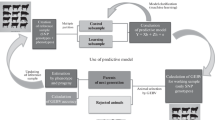Abstract
Genomic selection can have a major impact on animal breeding programs, especially where traits that are important in the breeding objective are hard to select for otherwise. Genomic selection provides more accurate estimates for breeding value earlier in the life of breeding animals, giving more selection accuracy and allowing lower generation intervals. From sheep to dairy cattle, the rates of genetic improvement could increase from 20 to 100 % and hard-to-measure traits can be improved more effectively.
Reference populations for genomic selection need to be large, with thousands of animals measured for phenotype and genotype. The smaller the effective size of the breeding population, the larger the DNA segments they potentially share and the more accurate genomic prediction will be. The relative contribution of information from relatives in the reference population will be larger if the baseline accuracy is low, but such information is limited to closely related individuals and does not last over generations.
Access this chapter
Tax calculation will be finalised at checkout
Purchases are for personal use only
Similar content being viewed by others
References
Goddard ME (2009) Genomic selection: prediction of accuracy and maximisation of long term response. Genetica 136:245–257
Hazel LN (1943) The genetic basis for constructing selection indexes. Genetics 28:476–490
Bijma P (2012) Accuracies of estimated breeding values from ordinary genetic evaluations do not reflect the correlation between true and estimated breeding values in selected populations. J Anim Breed Genet 129:1–14
Lande R, Thompson R (1990) Efficiency of marker-assisted selection in the improvement of quantitative traits. Genetics 124:743–756
James JW (1987) Determination of optimal selection policies. J Anim Breed Genet 104:23–27
Ducrocq V, Quaas RL (1988) Prediction of genetic response to truncation selection across generations. J Dairy Sci 71:2543–2553
Habier D, Fernando RL, Dekkers JCM (2007) The impact of genetic relationship information on genome-assisted breeding values. Genetics 177:2389–2397
Goddard ME, Hayes BJ, Meuwissen TH (2011) Using the genomic relationship matrix to predict the accuracy of genomic selection. J Anim Breed Genet 128:409–421
Clark SA, Hickey JM, Daetwyler HD, van der Werf JHJ (2012) The importance of information on relatives for the prediction of genomic breeding values and the implications for the makeup of reference data sets in livestock breeding schemes. Genet Sel Evol 44:4
Daetwyler H, Villanueva B, Woolliams JA, Weedon N (2008) Accuracy of predicting the genetic risk of disease using a genome wide approach. PLoS One 3:e3395. doi:Doi:10.137
Cervantes I, Goyache F, Molina A, Valera M, Gutierrez JP (2011) Estimation of effective population size from the rate of co-ancestry in pedigreed populations. J Anim Breed Genet 128:56–63
Kijas JW, Lenstra JA, Hayes BJ et al (2012) Genome-wide analysis of the world’s sheep breeds reveals high of historic mixture and strong recent selection. PLoS Biol 10:e1001258
Hayes BJ, Visscher PM, Goddard ME (2009) Increased accuracy of artificial selection by using the realized relationship matrix. Genet Res 91:47–60
Van der Werf JHJ (2009) Potential benefit of genomic selection in sheep. Proc Assoc Advmt Anim Breed Genet 18:38
Acknowledgements
The chapter is based on ideas that were developed mainly during work associated with the Australian sheep CRC data and discussion with the team and other colleagues. For this, Hans Daetwyler, Sam Clark, Andrew Swan, Nasir Moghaddar, Ben Hayes, John Henshall, Brian Kinghorn, John Hickey, and Rob Banks are acknowledged.
Author information
Authors and Affiliations
Editor information
Editors and Affiliations
Rights and permissions
Copyright information
© 2013 Springer Science+Business Media, LLC
About this protocol
Cite this protocol
van der Werf, J. (2013). Genomic Selection in Animal Breeding Programs. In: Gondro, C., van der Werf, J., Hayes, B. (eds) Genome-Wide Association Studies and Genomic Prediction. Methods in Molecular Biology, vol 1019. Humana Press, Totowa, NJ. https://doi.org/10.1007/978-1-62703-447-0_26
Download citation
DOI: https://doi.org/10.1007/978-1-62703-447-0_26
Published:
Publisher Name: Humana Press, Totowa, NJ
Print ISBN: 978-1-62703-446-3
Online ISBN: 978-1-62703-447-0
eBook Packages: Springer Protocols




